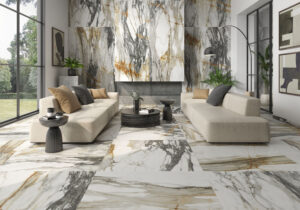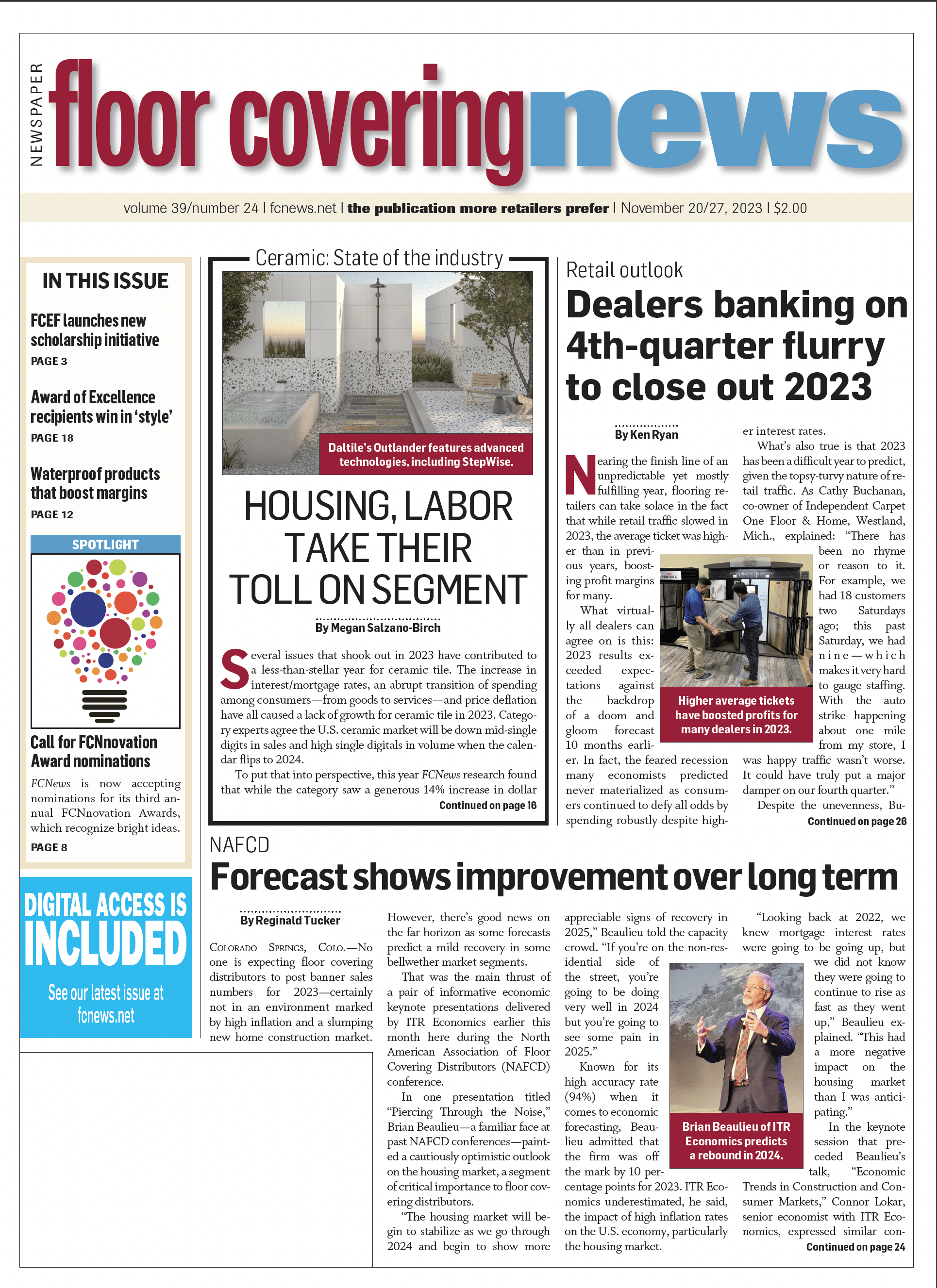
Several issues that shook out in 2023 have contributed to a less-than-stellar year for ceramic tile. The increase in interest/mortgage rates, an abrupt transition of spending among consumers—from goods to services—and price deflation have all caused a lack of growth for ceramic tile in 2023. Category experts agree the U.S. ceramic market will be down mid-single digits in sales and high single digitals in volume when the calendar flips to 2024.
To put that into perspective, this year Floor Covering News research found that while the category saw a generous 14% increase in dollar sales in 2022 (to $3.507 billion vs. $3.077 billion in 2021), it was buoyed by hefty price increases. That was illustrated by the 1% decrease in volume (to 2.453 billion square feet from 2021’s 2.477 billion square feet). It was, however, a sizeable 23% increase in sales from 2020’s $2.844 billion when the category experienced its first decline since 2009 amid the Great Recession. That $3.507 billion was a record high for the category and 2.442 billion square feet is still the third-highest volume total since 2006 when housing sales were at unprecedented levels.
However, 2023 saw those prices level out and will no doubt have a great impact on those record-breaking sales numbers when the dust settles at the end of the year.

Housing impacts sales
Housing has a major impact on ceramic sales in the U.S., and it’s a good gauge against which to judge the market. This year was no exception, and the tumultuous housing market impacted the tile category greatly. Challenges across the board—mortgage/interest rates, construction costs, declining housing starts and affordability, etc.—cut deeply into spending.
“The decline [in ceramic sales/volume] is due in part to the decrease in home starts, which are closely linked with tile consumption,” explained Eric Astrachan, executive director, TCNA. “The National Association of Home Builders (NAHB) estimates new home starts for 2023 will be at 1.4 million units, down 9.7% from the previous year. The residential market is struggling due to affordability concerns caused by soaring interest rates, inflation, labor issues and material shortages and high costs.”
In October, for example, overall housing starts increased 1.9% in October to a seasonally adjusted annual rate of 1.37 million units, according to a report from the U.S. Department of Housing and Urban Development and the U.S. Census Bureau. Within this overall number, single-family starts increased 0.2% to a 970,000 seasonally adjusted annual rate. However, single-family starts are still down 10.6% year-to-date.
Dal-Tile’s senior vice president of sales, Scott Maslowski, agreed that housing has impacted the category, noting the effect of rising costs. “You had a significant slowdown in housing, especially as the year progressed, between inflation and the interest rates rising. It has put a lot of pressure on the category. People aren’t buying new homes as quickly as they did before when the rates were 3% or 4% and, at the same time, people are a little hesitant on spending money in the residential remodel sector. They’re not sure what’s happening with the economy as the Fed’s pushing hard to get inflation under control.”

Installer shortage
Another major challenge for the ceramic category, and perhaps its most pressing, is the growing shortage of qualified labor. The ceramic flooring category is disproportionately impacted by this crisis when compared to others due to its need for highly skilled—not just skilled—labor.
“Innovation in tile manufacturing and design, although opening the door for more opportunity to increase tile sales, requires more specialization and training for those being hired to install it,” explained Bart Bettiga, executive director, National Tile Contractors Association (NTCA). “Tiles are being produced in larger size formats, different thicknesses and with many patterns and designs and sizes. These products require more training and skills to successfully install them on residential and commercial projects.”
A lack of qualified labor, while impacting tile’s ability to be properly installed, also has another major impact: costs. “Installation costs remains the biggest issue with ceramic tile,” said Raj Shah, co-CEO, MSI. “If installation headaches and costs are taken off the table almost all consumers would want ceramic tile. It’s the original waterproof product, has the most aesthetic options and holds up the best overtime. The issue is the cost and time of installation. The solution is to continue to increase the number of installers for tile. This will take a long-term approach in vocational schools and training.”
A long-term approach is exactly what the tile industry is moving toward with significant progress being made by many stakeholders in the industry. “Speaking for the NTCA, we have made a significant investment in our time and resources to explore multiple avenues to create a difference,” Bettiga noted. “Much of this is part of a long-term objective. Awareness and education of tile installation as a career at the middle and high school levels, including opportunities for both men and women, and emphasizing the artistic elements of ceramic tile installation, are all part of our strategy to help encourage people to enter our trade. We are expanding our outreach to include ceramic tile installation curriculum in technical and community colleges and encouraging others to enter into existing apprenticeship opportunities available. We are also offering our contractor members our services to help them develop apprenticeship programs on their own or in partnership with other local contractors in their region.”
Daltile’s Maslowski agreed that solutions are needed. “Unfortunately, it’s not an on/off switch, and it’s going to take some time. We have partnered more closely than ever with several organizations—whether it be the NTCA or TCNA, etc.—to get more training and get folks involved in that training. We’ve also started to partner in local markets. We’re trying to get ceramic tile back into trade schools and making it more of a mainstream opportunity.”
Trends and innovation
While challenges abound, the tile industry is perhaps one of the most technologically advanced flooring categories in the market—as well as the most design-forward—a true draw for consumers today. It is also one of only two truly aspirational product categories available in the market today.
“Ceramic tile continues to increase its value proposition to U.S. consumers through continued innovation and investments,” TCNA’s Astrachan noted.
For Astrachan, much innovation in tile is currently focused on sustainable initiatives such as carbon neutrality—a heavy hitter for many specifiers and designers in the space. “There is a rising demand for low carbon products,” he said. “To assist consumers, specifiers, architects, designers, purchasers and carbon accountants selecting low carbon products, the tile industry is investing in valuable embodied carbon tools. As the world strives to reduce overall carbon emissions, understanding proper calculation and reporting for building materials is crucial, as carbon emissions continue to occur during the construction and use phases of a product’s life.”
Digital decoration is another win for the tile industry when it comes to innovation. “With digital decoration improving dramatically—especially in the past two years—the visual and technical benefits of ceramics are expanding dramatically,” explained Rocamador Rubio, director of Tile of Spain for the USA. “The ability to digitally decorate porcelain slabs and panels makes for a massive value-add for ceramics in the worktop and furniture application fields. But for everyday dimensional tiles, the value for money has improved dramatically for the consumer. Beneath the surface, or at least non-visibly, there are multiple value-adds going into glaze layers from antimicrobial/antiviral surfaces to slip-resistance that actually improves when wet—there are value propositions for nearly any contingency. If you’re still thinking ceramic tile is for the areas or projects that your client can’t afford ‘the real thing’ you’re doing yourself a disservice.”
Daltile’s Maslowski agreed, noting tile’s ability to clad nearly every surface in the home today. “More and more, tile isn’t about making a purchase, it’s about a life change—whether it be something new or a remodel. The wall, the countertop, the back splash, indoors, outdoors—it’s more than just a flooring experience at this point.”
However, with vast combinations and options comes responsibility. “Ceramic tile has come such a long way the last few years,” MSI’s Shah said. “From large-format tile to new forms of wall tile to slabs to pavers and then thousands of looks and finishes within each type. There is so much choice. The problem is that it’s getting to the point of confusion for the end consumer. As an industry, we need to make it easier, faster and cheaper for consumers to see the choices and make decisions. A lot of visualization tools are now on the market, but we need to continue to provide training and education to retail associates to help them help the consumer.”

